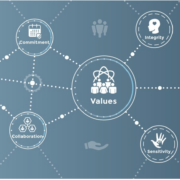Cash Flow Management for Nonprofits
When it comes to managing the finances of a nonprofit, cash flow is essential to both operations and future-facing decision-making. Understanding cash flow reporting, however, can be challenging for accounting teams, boards of directors, and leadership for many reasons.
Cashflow at its most simple is the inflow and outflow of cash.
Cash flow reporting means income is only reported when it is in hand. That is different than accrual-based accounting in which reports are based on accounts receivable and accounts payable. Accrual-based reporting recognizes income when it is earned, and expenses when they are incurred, not when the income is received and the expenses are paid.
An accounting team that is used to reporting accrual-based income would book income when a donation is pledged, for example. If, however, that donation is delayed for any reason, a fiscal year or quarter can end without those funds being received, significantly skewing the nonprofit’s cash flow reports. Because the structure of nonprofits is different than that of for-profit companies, using cash flow management as a tool for a deeper understanding of the organization’s financial standing can be especially helpful.
Endowments, restricted funds, and cash reserves are best tracked with cash flow reporting and not accrual-based accounting for this reason. For many nonprofits, their accounting departments and leadership teams find the complexities of cash flow management challenging and time-consuming. Reports can be data-intensive and difficult to understand. For other nonprofits, the level of reporting can be too basic for more sophisticated boards of directors, such as those with high-powered CEOs and former business leaders of large for-profit companies.
As valuable as the insights that come from reviewing a trailing twelve-month cash flow report can be to forecasting and budget creation, many nonprofit organizations find that the overwhelming amount of data involved in reviewing a year of cash flow reporting makes it difficult to base intelligent decisions on cash flow numbers. For each nonprofit, the right amount of cash flow reporting will vary in order to meet the needs of leadership teams and boards of directors while still remaining accountable to donors, grantors, governments, and charity watchdog agencies.
The big question for donors, watchdogs, government auditors, and grantors is: Where did the money go? If you can’t answer that question, fundraising will likely be increasingly difficult. Because of this elevated level of scrutiny, it is essential that nonprofits manage cash flow with great attention to detail and to the highest standards of grant and government accounting.

Should you run your nonprofit like a for-profit?
It’s a common refrain: you should run your nonprofit like a for-profit. But is it accurate? Despite what many high-powered businesspeople suggest, nonprofits are not merely under-developed for-profits. There are key considerations that nonprofits must weigh, especially when it comes to cash flow.
- Nonprofits are not focused on asset accumulation, and they cannot use net assets as leverage to raise cash.
- Nonprofits exist at the mercy of the IRS. The 501c3 designation is a tax charter bestowed upon organizations by the IRS allowing tax-deductible contributions in exchange for their good works. Regular audits are required in order to retain that coveted status.
- Nonprofits do not always have access to the cash in their bank accounts. With certain donations earmarked for certain programs, restricted donor funds are not counted the same as unrestricted donor funds.
- Nonprofits are contractually obliged to spend funds in the way in which their charter was formed.
- A for-profit business’ annual fiscal cycle takes into account year-end distributions, dividends, and taxes while a nonprofit’s fiscal cycles are focused on expenditures and donations, tracked with cash flow management.
- Nonprofits file annual 990 reports that compare operational expenses and program expenses. Those reports are made public, and donors use them to discern the efficacy of the organization. Without impeccable cash flow reporting, those 990s can show inaccurate spending.
Leaders in nonprofits pay close attention to assets and liabilities. But sometimes that leads to complex fiscal questions. Statements of Financial Positions can look very strong because of endowments, whereas access to those funds can be highly restricted for operational expenses. Impeccable, accessible, and easy-to-read cash flow reporting is paramount to communicating the realities of a nonprofit’s fiscal situation to a board, donor or to government entities.
Donor-restricted funding
Nonprofits often have inflows of cash that are earmarked for specific initiatives, either by the donor or a grant, making accurate management and reporting of cash flow even more important.
To make matters more complex, all nonprofits over $2M have to be audited annually in order to retain their 503c status. Managing cash flow is therefore highly consequential to the day-to-day running of a not-for-profit as well as to the future funding of the organization. For nonprofit accounting departments, the importance of good cash management, and a strong understanding of your cash flow cannot be overstated.
What are some nonprofit pitfalls?
Challenge: Sophisticated BODs require extensive reporting:
A really savvy board of directors (BOD) can be demanding. Your BOD may be made up of CEOs of $50M companies who know what they need in order to make informed decisions about the future of the nonprofit. When not-for-profit accounting teams are asked to adhere to elevated standards of accounting and, additionally, asked to provide sophisticated financial reporting, they can become overburdened, or burned out. Hiring a full, in-house finance and accounting team, however, can be prohibitively expensive especially as reported in operating expenses on the 990. This is one of the reasons that a fractional accounting team is such a powerful and flexible tool for nonprofits.
Challenge: Hiring increases operational expenses
Implementing a leveraged accounting team that fits into an annual budget means that your report on your 990 shows a healthy balance between overhead and project spend. With deep knowledge of 990 preparation, a Signature Analytics team can assist your organization in reporting spending accurately and to the highest possible standards expected by auditors, grantors, Boards of Directors, and donors.
Challenge: Tracking earmarked funds is complex and time-consuming
Due to significant changes in accounting regulation, the accounting departments of nonprofits are under increased pressure to manage their finances with transparency and impeccable reporting practices. New Financial Accounting Standards Board (FASB) standards require nonprofits to report finances in a way that makes it clear which funds have donor restrictions and which funds come without donor restrictions. The updated requirements dictate that nonprofits show these categories on financial statements by having separate columns for “without donor restrictions” and “with donor restrictions.” or by showing separate line items in the revenue section of the Statement of Activities.
Cash Flow Management for Nonprofits in 3 Simple Steps
1. Anticipate and Plan for Future Cash Needs
Having accurate, timely, and relevant (ART) reporting helps build a cash flow management system based on accurate historical data. Looking at a trailing twelve-month (TTM) cash flow statement can give crucial insights into the patterns you have in spending and the ebbs and flows of fundraising. A rolling cash forecast tracks estimated inflows, such as donations and fundraising, and outflows, such as vendor payments and payroll. With accurate data, you can better plan for program expenses and avoid cash flow surprises.
2. Allocate Funds Intentionally
With accurate cash flow reporting, you can make strategic decisions about where to allocate your organization’s funds. It can be much clearer which programs have the highest return on investment (ROI), and which make the greatest impact in your community with the least investment. Cutting underperforming or ineffective programs can improve outcomes for your participants, your donors, and your statement of financial position.
3. Keep funds safe from fraud.
Nonprofits have increased susceptibility to fraud. The greatest risk of fraud stems from internal stakeholders who, through poor internal controls or long tenures, no longer have oversight of their financial dealings. With the additional oversight your organization is under, all it takes is one mistake to compromise the future of your organization. The best way to eliminate fraud and unauthorized use of your company bank accounts is to have an outsourced partner who keeps tabs on the people who have access to your financial systems.
How Signature Analytics Can Help Your Nonprofit
Signature Analytics’ nonprofit accounting services help you make financial decisions based on the highest quality accounting practices, while our day-to-day outsourced accounting teams implement the highest quality donor and government accounting standards.
For additional assistance with cash flow management, developing detailed nonprofit budgets, and audit support, contact Signature Analytics today.











